November 2025
The global agricultural fumigants market volume was accounted for 350.21 Kilo Tons in 2024 and is expected to be worth around 540.34 Kilo Tons by 2034, growing at a compound annual growth rate (CAGR) of 4.43% during the forecast period 2025 to 2034. The rising focus on sustainable and eco-friendly alternatives due to the rising demand from farmers to protect crops from pests and diseases drives the growth of the market.
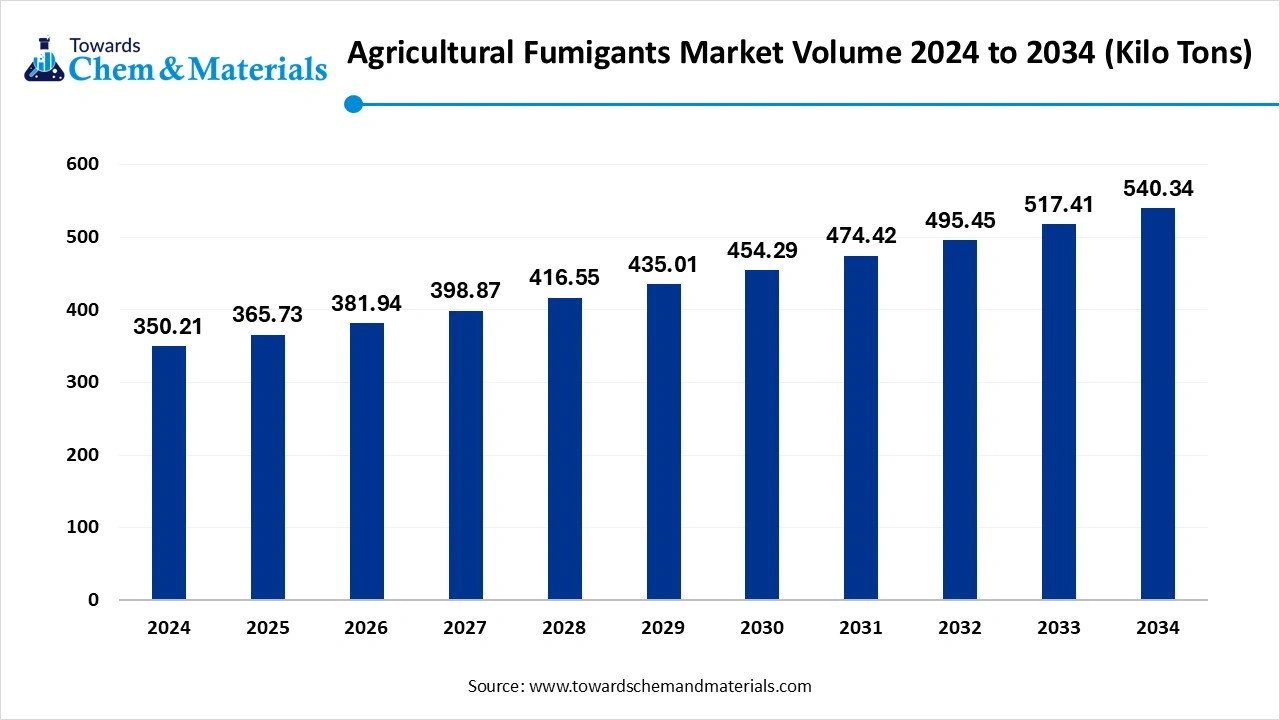
Fumigation is a process that involves pest control, which helps remove harmful pests and microorganisms. Fumigants are gaseous vapours and materials which is used to control insects and rodents, also sterilize stored grains, food, and other agricultural commodities. Fumigants are highly volatile liquids which does not leave any residue on the product after fumigation. It involves filling an area with a fumigant gas, which is then allowed to penetrate and kill pests.
This method is effective because fumigants can reach pests within the commodities and in enclosed spaces, unlike some other insecticides. Benefits of fumigation involve effective pest control, prevention of damage and losses, and protection of commodities. Sustainable agricultural fumigants adoption aligns with rising environmental concerns, driving the growth of the market.
The agricultural fumigants market growth is driven by a shift towards rising adoption of sustainable alternatives to the toxic fumigants drives the demand for the market, with rising environmental concerns driving the growth. The rising population demand for an increase in crop production due to higher demand helps grow. Storing grain and crops safely also requires and demands pest control, which ensures crop quality, which supports the growth of the market. Advancement and new and modern storage facilities for effective fumigation drive the demand and help in the expansion of the market. Government initiatives that support food security and also promote less harvest loss attract the farmers to practice sustainable farming practices and also help grow the market. Climate change and rising pest incidence contribute to higher demand for the use of effective agricultural fumigation solutions, which supports the growth of the market.
| Report Attributes | Details |
| Market Volume in 2025 | 365.73 Kilo Tons |
| Market Volume by 2034 | 540.34 Kilo Tons |
| Growth Rate from 2025 to 2034 | CAGR 4.43% |
| Base Year of Estimation | 2024 |
| Forecast Period | 2025 - 2034 |
| High Impact Region | North America |
| Segment Covered | By Product,By Application, By Region |
| Key Companies Profiled | Dow, Bayer AG, Arkema, AMVAC Chemical Corporation, LANXESS, BASF, Trinity Manufacturing, Inc., Arysta LifeScience Corporation, Novozymes A/S, part of Novonesis Group, Syngenta International AG, Corteva Agriscience, Detia Degesch GmbH, UPL Limited, SGS SA, MustGrow Biologics Corp., |
The key opportunity responsible for the growth of the agricultural fumigants market is the development of new fumigant technology, which mainly focuses on innovation and advancement in technology for developing environmentally friendly fumigants, which supports the growth of the market. The government initiatives to support and offer farmers with fumigation practices and solutions, and storage facilities support the growth of the market. The agricultural fumigants also offer increasing agricultural production and support food safety concerns, resulting in minimizing and reducing post-harvest losses, which creates a great opportunity for the growth of the market by increasing adoption by the farmers due to the benefits associated with it.
The rising environmental concerns are due to the rise in ozone layer depletion, due to the release of harmful toxic chemical fumes, and it also leads to health risks due to constant exposure, like respiratory diseases, skin irritation, and also affects soil and water quality as it leads to contamination. Extensive and repeated use of fumigants also develops resistance in pests, which then leads to crop failure this resulting in hindrance of the growth of the market. The raw material price and labor cost also add to the challenge for the growth of the market. The adoption of new technology and adoption of sustainable practices affects the growth. These factors and challenges hinder the growth of the market. The region is also focusing on the development of bio-based alternatives to traditional fumigants to safer alternatives that support the market growth.
How Did North America Dominate the Agricultural Fumigants Market in 2024?
North America dominated the agricultural fumigants market in 2024. The regions' rising focus on food safety regulation and stringent regulations, and ensuring protection of crops for storage and transportation, drives the growth of the market. Rising demand for agricultural products in the region due to increasing consumption of the products aligns with the shift towards green and sustainable use of products. Consumers' demand for green and safe products due to a shift towards healthy product use and green products fuels the growth of the market. The region well well-developed infrastructure and well-developed storage facilities like warehouses, also undergo effective pest control, driving the demand for the market. Advances in fumigation equipment to enhance efficiency, safety, and precision drive the growth and expansion of the market in the region.
The USA Has Seen a Steady Growth in the Agricultural Fumigants Market Due to Increasing Demand
The USA agricultural fumigants market has seen steady growth with rising demand for pest control in crops to protect them from insects and diseases, which demands sustainable and eco-friendly fumigants in the country. The fumigants are used in pre-plant soil treatment and post-harvest treatment, which increases the demand for the fumigants in the country. The country’s increased demand for food security to ensure food production, and also advances and innovations in technology, with evolving crop protection techniques, which are becoming more adoptable by the farmers. These factors support the growth and expansion of the market in the country.
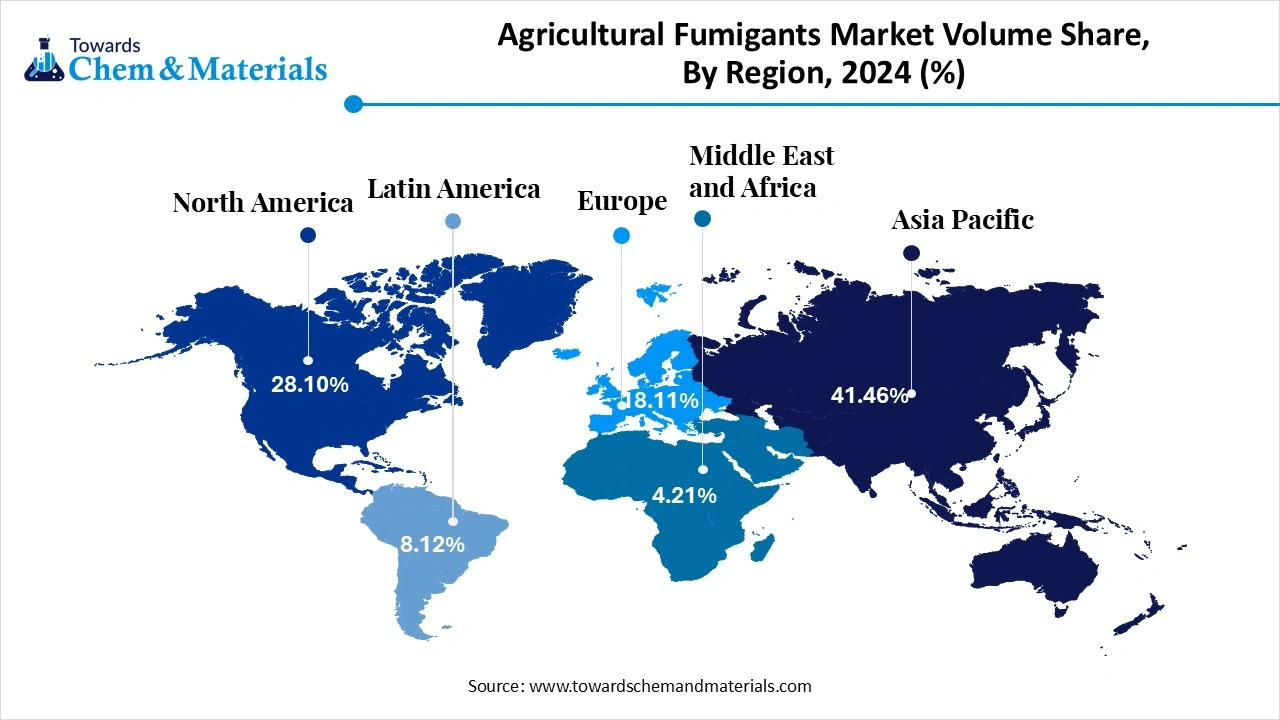
Asia Pacific is Experiencing Steady Growth in the Agricultural Fumigants Market Due to Large Agricultural Practices in the Region.
Asia Pacific held the significant share of the market in 2024 and is expected to grow notably during the forecast period. Asia Pacific has seen significant growth as it holds the largest consumer of agricultural fumigants due to large agricultural practices in the region. The increasing demand from farmers for green and eco-friendly fumigants, with changing climate conditions and a rise in the need for pest control, drives the market in the region. The humid and rigorous changing climate in the region results in high outbreaks of pests and insects in the warehouses and storage areas in the region, which increases the demand for pest control and effective fumigants, which drives the growth of the market.
China is the Largest Market in the Region for the Agricultural Fumigants Market
China has seen steady growth in the agricultural fumigants market, which is a large farming practice in the country due to increasing demand because of the rising population in the country. The demand for organic products is rising, and China is the leading producer of vegetables due to high demand. The government policies of domestic and local use of products increase the large adoption of local products, which contributes to the growth of the market. Key companies are investing in formulating innovative and advanced fumigants for the protection of crops from failure, and also stored grains. These factors and applications drive the growth and expansion of the market in the country.
Agricultural Fumigants MarketVolume Share, By Region, 2024-2034 (%)
| By Region | Volume Share, 2024 (%) | Volume Kilo Tons - 2024 | Volume Share, 2034 (%) | Volume Kilo Tons - 2034 | CAGR (2025 - 2034) |
| North America | 28.10% | 98.41 | 25.67% | 138.71 | 3.49% |
| Europe | 18.11% | 63.42 | 17.23% | 93.10 | 3.91% |
| Asia Pacific | 41.46% | 145.20 | 43.83% | 236.83 | 5.01% |
| Latin America | 8.12% | 28.44 | 9.03% | 48.79 | 5.55% |
| Middle East & Africa | 4.21% | 14.74 | 4.24% | 22.91 | 4.51% |
| Total | 100% | 350.21 | 100% | 540.34 | 4.43% |
The phosphine segment dominated the agricultural fumigants market in 2024. The growth of the market is driven by the growing need for effective, efficient, and cost-effective alternatives to the traditional fumigants. Phosphine is highly effective at low concentrations in controlling a large range of pests, which drives the demand for the market. Phosphine can penetrate deeply and ensures effective pest control, and it also does not leave harmful residues on the product, which also attracts the consumers, driving the demand for the market. It is an easy-to-apply fumigant and is a popular choice by farmers and storage facilities.
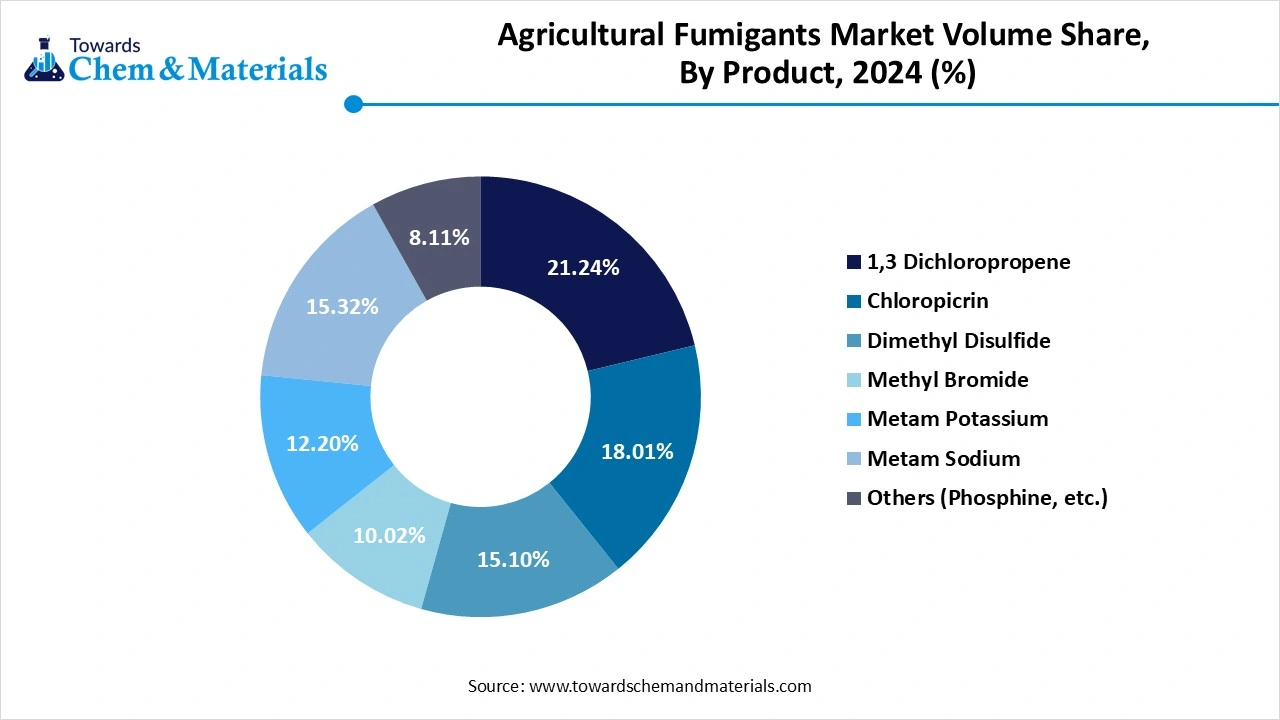
The low cost, ease of application, and compliance are the factors that drive the growth and expansion of the market. The 1,3-dichloropropene segment expects significant growth in the market during the forecast period. The segment is favoured for its effectiveness, short soil residence time, and compatibility with pest management, which helps grow the market. They are commonly used to control nematodes, soil-borne pathogens, and certain weeds in high-value crops. It is considered to be the most viable alternative to methyl bromide, which is toxic, commonly used for vegetables and fruits. The rising groundwater and environmental contamination the adoption of the segment has increased which resulting in a rise in growth and expansion of the market.
Agricultural Fumigants Market Volume Share, By Product, 2024-2034 (%)
| By Product | Volume Share, 2024 (%) | Volume Kilo Tons - 2024 | Volume Share, 2034 (%) | Volume Kilo Tons - 2034 | CAGR (2025 - 2034) |
| 1,3 Dichloropropene | 21.24% | 74.38 | 17.10% | 92.40 | 2.19% |
| Chloropicrin | 18.01% | 63.07 | 17.10% | 92.40 | 3.89% |
| Dimethyl Disulfide | 15.10% | 52.88 | 18.12% | 97.91 | 7.08% |
| Methyl Bromide | 10.02% | 35.09 | 7.34% | 39.66 | 1.37% |
| Metam Potassium | 12.20% | 42.73 | 15.12% | 81.70 | 7.47% |
| Metam Sodium | 15.32% | 53.65 | 18.11% | 97.86 | 6.91% |
| Others (Phosphine, etc.) | 8.11% | 28.40 | 7.11% | 38.42 | 3.41% |
| Total | 100% | 350.21 | 100% | 540.34 | 4.43% |
The soil segment dominated the agricultural fumigants market in 2024. Soil fumigation is a pre-plant pest control method that is used to sterilize soil by eliminating harmful organisms such as nematodes, bacteria, fungi, insects, and weed seeds, raising the demand for the market. This is useful in improving crop health and productivity of the crop by implementing and creating a pest-free environment by managing and complying with environmental and safety regulations. These factors drive the growth of the market and also help in expansion.
The liquid segment dominated the agricultural fumigants market in 2024. The fumigants are applied in the liquid form to the soil to control pests such as nematodes, bacteria, fungi, insects, and weed seeds before planting, which helps yield a good crop. Liquid fumigants are extensively used in high-value crop cultivation due to their efficiency and ease of application. This is done by drip irrigation and by injecting them directly into the soil. It also helps minimise the environmental impact and ensures safety; these factors and applications drive the growth of the market.
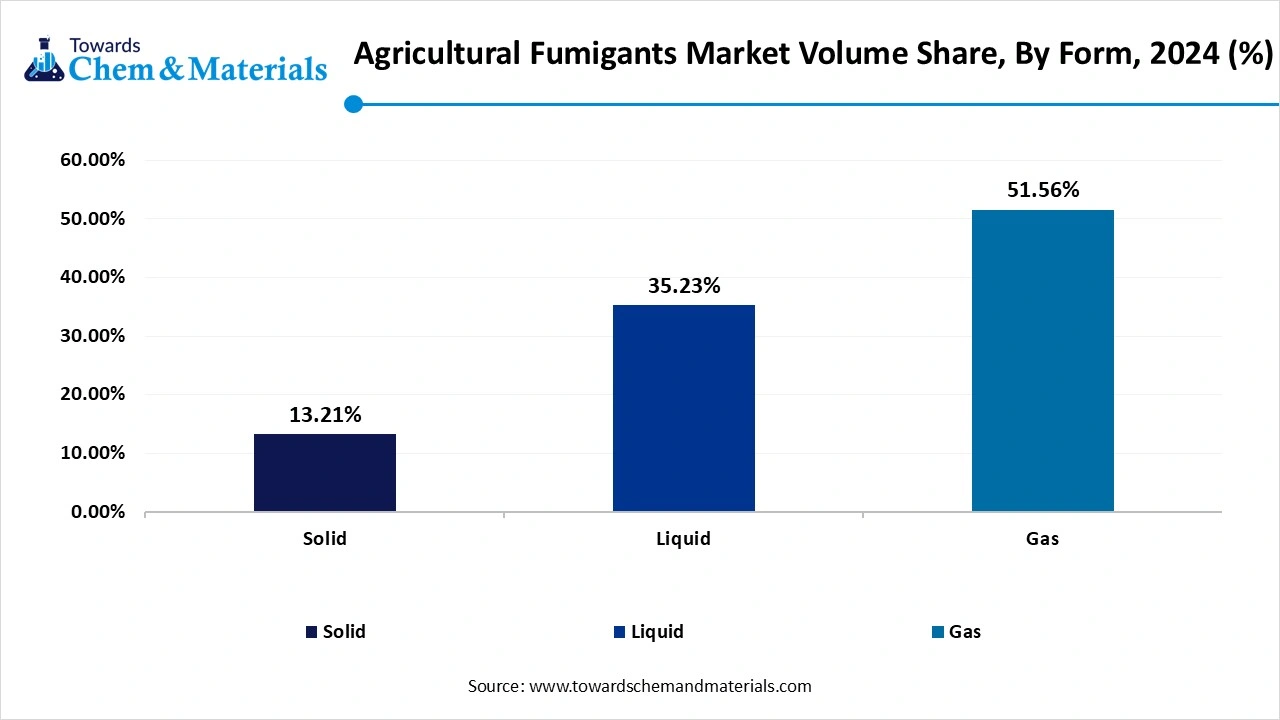
The gas segment expects significant growth in the market during the forecast period. These are applied in vapour form to control pests on both soil and storage. They are extensively used in pre-plant soil treatment to prepare the soil and are also used in fumigating the stored grains. These gases deeply penetrate and kill the pests and insects, by offering rapid action and high efficacy. These properties attract the farmers for large adoption, which results in the growth and expansion of the market.
Agricultural Fumigants Market Volume Share, By Form, 2024-2034 (%)
| By Form | Volume Share, 2024 (%) | Volume Kilo Tons - 2024 | Volume Share, 2034 (%) | Volume Kilo Tons - 2034 | CAGR (2025 - 2034) |
| Solid | 13.21% | 46.26 | 14.33% | 77.43 | 5.29% |
| Liquid | 35.23% | 123.38 | 37.34% | 201.76 | 5.04% |
| Gas | 51.56% | 180.57 | 48.33% | 261.15 | 3.76% |
| Total | 100% | 350.21 | 100% | 540.34 | 4.43% |
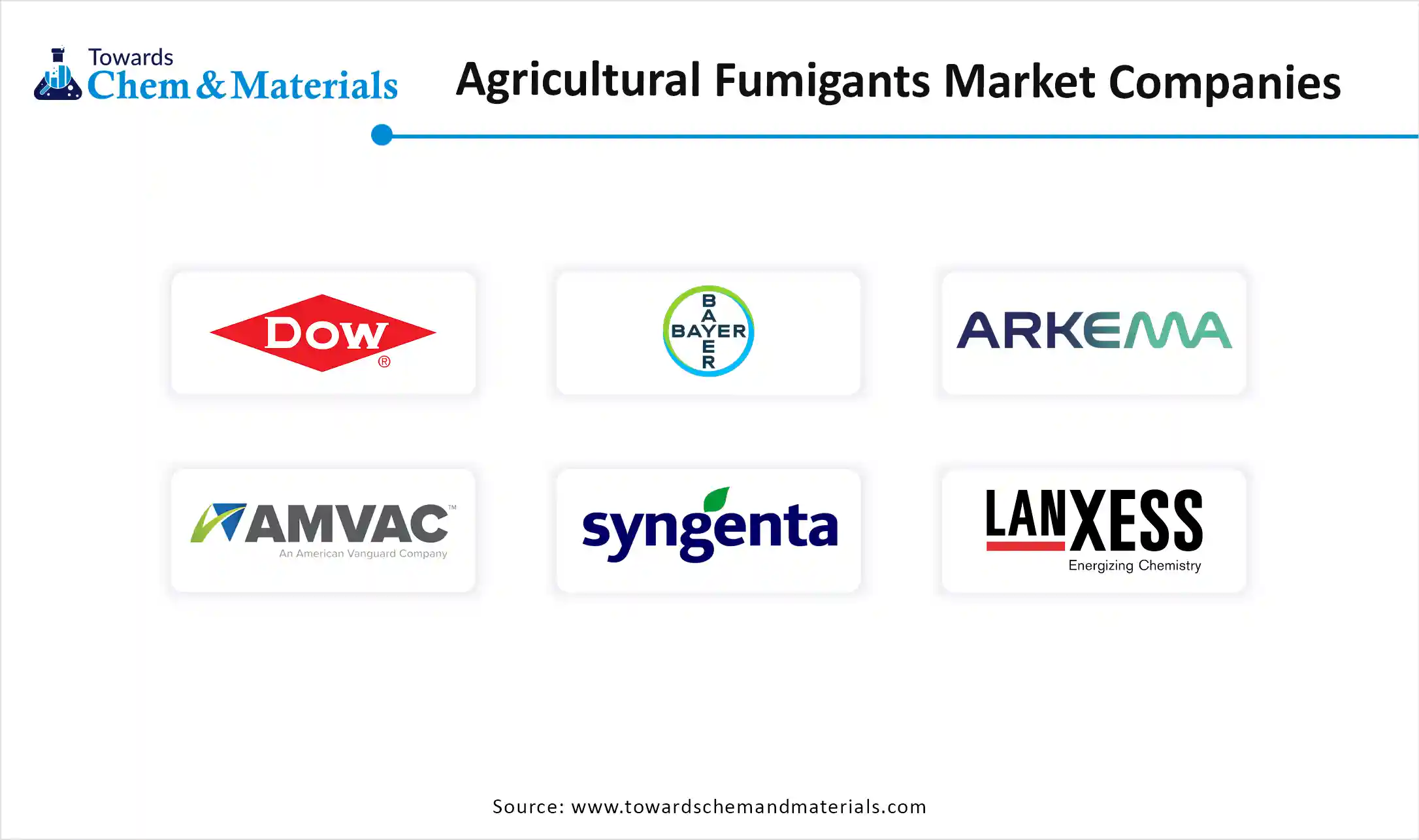
By Product
By Application
By Form
By Region
November 2025
November 2025
September 2025
August 2025